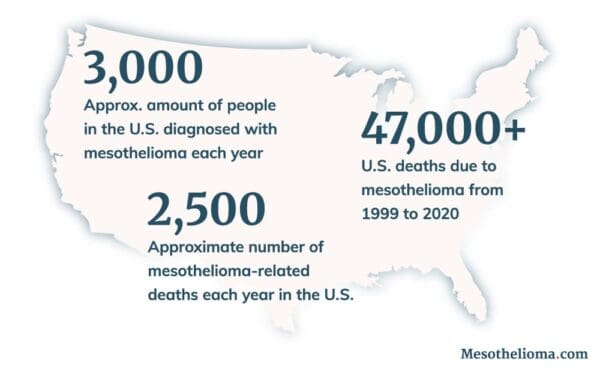Key Mesothelioma Facts
Mesothelioma is a type of cancer that develops in the linings of various organs. It most commonly occurs in the pleura, the lining around the lungs. Less commonly, it can develop in the lining around the abdomen (peritoneum), lining around the heart (pericardium) and lining around the testicles (tunica vaginalis).
Understanding key facts about mesothelioma can help patients make informed decisions and set expectations for their cancer journey. Mesothelioma facts and statistics may also be useful in raising awareness of the disease.
- Mesothelioma is caused by asbestos exposure.
- In 2019, mesothelioma accounted for less than 0.2% of all cancer diagnoses in the United States.
- There are approximately 3,000 new mesothelioma diagnoses each year in the United States.
- There are roughly 2,500 mesothelioma deaths in the United States annually.
- There are four types of mesothelioma: pleural, peritoneal, pericardial and testicular.
- There are three main mesothelioma cell types: epithelioid, sarcomatoid and biphasic.
- Mesothelioma symptoms typically do not develop until 10 – 50 years after asbestos exposure. This delay is known as a latency period.
- Overall mesothelioma life expectancy is 18 – 31 months with treatment. This can vary significantly based on many factors and may be improved.
Statistics by Type of Mesothelioma
There are four types of mesothelioma differentiated by where the cancer originates. The location of the cancer impacts how the disease will develop and be treated.
This table shows the number of malignant mesothelioma cases reported from 1999 to 2018, broken down by type. It highlights how pleural mesothelioma consistently accounted for the majority of cases each year.
Resources for Mesothelioma Patients
Mesothelioma Survival Statistics
Mesothelioma survival statistics can be reported as life expectancy (months or years) or survival rate (percentage of patients alive at a certain time).
- Mesothelioma life expectancy: The life expectancy for pleural mesothelioma is 18 months. For peritoneal mesothelioma it is 31 months. These life expectancies apply to patients undergoing some form of treatment.
- Mesothelioma survival rate: The 3-year survival rate with treatment for pleural mesothelioma is 23% and the same rate for peritoneal mesothelioma is 74%.
Mesothelioma survival may vary based on several factors. These include the type and stage of mesothelioma. These factors can influence which treatments are likely to benefit a patient. Treatment is the best way to improve survival.
Factors that impact mesothelioma survival include:
- Age
- Gender
- Mesothelioma stage at the time of diagnosis
- Mesothelioma type
- Overall health
- Treatment approach
A doctor may discuss certain statistics when talking about a patient’s mesothelioma prognosis. Prognosis is an estimate of a patient’s overall disease outlook, which includes life expectancy and survival.
Survival Rates by Mesothelioma Type
Survival outcomes for mesothelioma vary greatly by type. Some forms have a much better prognosis than others. Peritoneal mesothelioma generally offers the most favorable outlook. Pleural, pericardial and testicular mesothelioma types have lower survival rates. The location of the cancer can influence life expectancy. While some survival statistics may seem discouraging, mesothelioma survival rates have been improving.
Recent advancements in treatments may help patients feel more hopeful about these statistics. Promising treatments, like immunotherapy, are helping to improve prognosis even for complex cases.
Survival Rates by Mesothelioma Stage
Another factor influencing survival is mesothelioma stage. Stage indicates how far the cancer has progressed. Those diagnosed at early stages often experience more favorable survival rates than those diagnosed in later stages of mesothelioma. These rates are largely due to cancer progression and the type of treatment options often available.
Malignant pleural mesothelioma is the most common form of the cancer. As a result, it is the most studied form of the disease. Pleural mesothelioma survival rate by stage is as follows:
- Stage 1 pleural mesothelioma: 2-year survival rate is around 41%, 5-year survival rate is around 33%
- Stage 2 pleural mesothelioma: 2-year survival rate is around 39%, 5-year survival rate is around 9%
- Stage 3 pleural mesothelioma: 2-year survival rate is around 29%, 5-year survival rate is around 6%
- Stage 4 pleural mesothelioma: 2-year survival rate is around 24%, 5-year survival rate is around 4%
Pleural mesothelioma is the only type with an established staging system of its own. Other types, such as pericardial mesothelioma, are so rare that they do not have their own designated staging system. Despite this, doctors with experience treating rare types of mesothelioma may still help increase patients’ quality of life and survival with individualized treatment plans.
Survival Rates by Age and Gender
Certain demographic factors may also impact survival. Research shows age at diagnosis, biological sex and gender may impact survival rates. For example, female mesothelioma patients generally have better survival rates than men.
| Age at Diagnosis | Male | Female |
|---|---|---|
| <45 | 32% | 53% |
| 45 – 54 | 18% | 32% |
| 55 – 64 | 13% | 18% |
| 65 – 74 | 7% | 16% |
| 75+ | 4% | 7% |
Data shows younger patients typically have better survival rates than older patients. This may be because younger patients tend to have better overall health and are often able to receive more aggressive mesothelioma treatments.
Mesothelioma Death Rate
Mesothelioma death rate refers to the rate of deaths caused by mesothelioma in a given time period. These statistics may also be referred to as mortality. The Centers for Disease Control and Prevention (CDC) reports:
- 54,905 people died in the United States from mesothelioma from 1999 to 2020
- ~2,500 mesothelioma deaths annually
Treatment may help patients extend life expectancy. Some long-term mesothelioma survivors have even lived for more than 15 years after their diagnosis.
Mesothelioma Death Rate by State
Mesothelioma death rate describes the rate of mesothelioma deaths per one million people. Mesothelioma death rates may vary by state. Differences could be due to increased levels of asbestos use and exposure in some states.
Mesothelioma Treatment Statistics
Mesothelioma treatment is the best way to extend patient survival and improve quality of life. A treatment’s impact on survival will vary depending on the individual. Patients who outlive their prognoses have usually undergone multimodal treatment. Multimodal treatment is when doctors use two or more treatment methods. Some mesothelioma doctors consider multimodal treatment the best chance for a cure.
Clinical trials may be an option for mesothelioma patients to try new treatment methods and combinations. Participation in trials may also help cut down on treatment costs and extend survival.
In a 2020 study, pleural mesothelioma patients received multiple treatments. Chemotherapy came first, then pleurectomy and decortication (P/D) surgery. Some patients also received additional chemotherapy after surgery. The study reported a few encouraging results:
- Median survival: ~5 years
- 1-year survival rate: 93%
- 3-year survival rate: 65%
Multimodal therapy has also helped peritoneal mesothelioma patients. One study combined surgery with heated intraperitoneal chemotherapy (HIPEC). Patients also received another type of chemotherapy. This approach had a positive impact on prognosis. The study reported:
- A median survival of 5.4 years
- A 5-year survival rate of 52%
Another recent study combined two forms of immunotherapy. Pleural mesothelioma patients received CAR T-cell therapy and Keytruda®. These patients had a median survival of about 24 months (2 years).
Who Gets Mesothelioma?
Any person exposed to asbestos is at risk of developing mesothelioma. There is no safe level of asbestos exposure. A number of risk factors can influence an individual’s likelihood of developing an asbestos disease, including long periods of exposure and age.
Mesothelioma statistics also show the disease is more commonly diagnosed in male patients, Caucasians and people who are 65 years old and older. It is rarer in women and people under 45 years of age.
Latency Period Statistics
Mesothelioma cancer has a long latency period. This refers to the length of time between asbestos exposure and the onset of mesothelioma.
It may take 10 – 50 years after asbestos exposure for a patient to develop symptoms. The median mesothelioma latency period is about 30 years. Studies indicate no significant statistical difference in latency period between pleural and peritoneal mesothelioma patients.
However, latency period may be affected by many other factors, including patient characteristics and occupation.
- Age: Some research indicates that the younger someone is at first exposure, the longer their latency period may be. For example, in one study individuals exposed before age 20 had a median latency of about 40 years. Patients exposed at 50 or older had a median latency of about 10 years.
- Occupation: People in certain occupations may face long-term or intense periods of asbestos exposure. As a result, they may be more likely to develop mesothelioma and have a shorter latency period. An Italian study measured the latency periods of people who had asbestos-related jobs. Insulators showed the shortest latency period at about 30 years. Women who experienced household exposure showed the longest period at about 50 years.
Occupations With High Asbestos Exposure Risk
Occupational asbestos exposure can affect people in many types of jobs. As discussed above, certain occupations may be associated with different latency periods. Similarly, certain occupations may be associated with increased risk of asbestos exposure and related disease development.
Some of the occupations with the highest risk of asbestos exposure include:
- Aircraft mechanics
- Auto mechanics
- Boiler workers
- Construction workers
- Firefighters
- HVAC workers
- Industrial workers
- Insulators
- Machine operators
- Machinists
- Mine workers
- Oil refinery workers
- Shipyard workers
- Textile mill workers
Mesothelioma Diagnosis Statistics by Age and Gender or Sex
Mesothelioma is more commonly diagnosed among male than female patients. Some research links this difference to men being at higher risk of occupational exposure during the height of asbestos use.
The latency period also affects age-related statistics, which increases the age at diagnosis. The average age at mesothelioma diagnosis may also differ with the type of mesothelioma.
- Peritoneal mesothelioma: Average age at diagnosis for peritoneal mesothelioma patients is about 51 years.
- Pleural mesothelioma: Average age at diagnosis for pleural mesothelioma patients is about 67 years.
The following statistics were gathered from the most recent data available from the CDC and the National Cancer Institute (NCI).
Mesothelioma Incidence Statistics By Gender and Age Group From 1999 to 2019
- Diagnoses by sex: 51,354 male individuals and 15,597 female individuals were diagnosed with mesothelioma in the United States.
- Diagnoses among those 80 years old and older: 19,179 cases
- Diagnoses among those 75 – 79 years old: 12,521 cases
- Diagnoses among those 70 – 74 years old: 11,021 cases
- Diagnoses among those 65 – 69 years old: 8,678 cases
- Diagnoses among those 60 – 64 years old: 6,091 cases
- Diagnoses among those 59 years old and younger: 9,447 cases
Mesothelioma Incidence by Race
The connection between race and mesothelioma incidence has not been fully studied. White, non-Hispanic people seem to have a higher incidence, but this may not be a true difference. *The statistic for American Indian and Alaska Native, Non-Hispanic is an estimate based on CDC data for total mesothelioma deaths in the country and deaths among other demographics.
| Race | Number of Cases Diagnosed in 2019 |
|---|---|
| White, Non-Hispanic | 2,402 |
| Hispanic | 265 |
| Black, Non-Hispanic | 152 |
| Asian and Pacific Islander, Non-Hispanic | 61 |
| American Indian and Alaska Native, Non-Hispanic | 31* |
Mesothelioma Incidence in the United States
Approximately 3,000 new cases of mesothelioma are diagnosed each year in the United States. Additionally, about 2,500 mesothelioma-related deaths occur in the United States each year.
The CDC collects information on both mesothelioma incidence rate and mortality rate (death rate). This data provides information regarding how many patients are diagnosed with mesothelioma and die from the cancer. The most recent information spans from 1999 to 2019 for incidence and 1999 to 2020 for mortality.
- 66,951 Americans were diagnosed with mesothelioma between 1999 and 2019.
- 54,905 Americans died from mesothelioma between 1999 and 2020.
- Mesothelioma mortality rates remain steady. Since 1999, the rate of deaths per one million people has remained between 6 and 9.
- Researchers estimate more than 20 million people in the United States are at risk of developing mesothelioma at some point in their lives.
It is also possible to break down statistics for mesothelioma cases by state. Analyzing statistics in this way may provide insights about geographical areas with more instances of naturally occurring asbestos, prevalence of high-risk occupations and other mesothelioma risk factors.
According to the most recent data available, spanning from 1999 to 2019, the southern United States experienced the most diagnosed cases of mesothelioma. This may be because of factors like more industry in this region or more natural asbestos deposits.
- Southern United States: 21,676 mesothelioma diagnoses
- Midwestern United States: 15,807 mesothelioma diagnoses
- Northeastern United States: 15,325 mesothelioma diagnoses
- Western United States: 14,143 mesothelioma diagnoses
However, broken down by state, Maine, West Virginia, Pennsylvania, Delaware and New Jersey had the highest rates of diagnoses. For states with the highest rates of death, the list is the same except Montana replaces New Jersey.
| Rate of Diagnoses per One Million* | Rate of Deaths per One Million** | |
|---|---|---|
| Maine | 19 | 17 |
| West Virginia | 17 | 13 |
| Pennsylvania | 16 | 13 |
| Delaware | 15 | 12 |
| New Jersey | 15 | 11 |
| Montana | 14 | 12 |
| National Rates | 10 | 8 |
*Diagnoses data from 1999 to 2019 **Mortality data from 1999 to 2020
Mesothelioma Cases Worldwide
Mesothelioma is a global problem stemming from frequent asbestos use around the world in the 20th century. A recent study found an estimated 30,000 deaths occur globally from mesothelioma each year. Although the exact global mortality rate is not confirmed, these statistics demonstrate that mesothelioma cancer is a global issue.
The areas with the highest rates of mesothelioma include the United Kingdom, Australia and Andorra.
Common Questions About Mesothelioma Facts and Statistics
- What percentage of people develop mesothelioma?
Because asbestos use was widespread, it is difficult to estimate how many people go on to develop mesothelioma. However, research indicates most people who have been exposed to asbestos do not develop mesothelioma. While no level of exposure is safe, asbestos diseases like mesothelioma generally develop in people who experienced regular occupational asbestos exposure.
- Are mesothelioma rates decreasing?
According to the most recent CDC data, mesothelioma rates may be trending slightly downward. However, many Americans are still at risk of exposure to asbestos and developing related diseases.
- What is the death rate of mesothelioma?
According to CDC Wonder data from 1999 to 2020, the national rate of mesothelioma deaths is 0.8 out of 100,000. This equates to about 8 deaths per one million citizens.
Note: This page contains statistics gleaned from large groups of patients. These statistics cannot forecast a single patient’s risk, cancer experience or the success of any given treatment. Patients should discuss all cancer screening and treatment decisions with an experienced oncologist.











